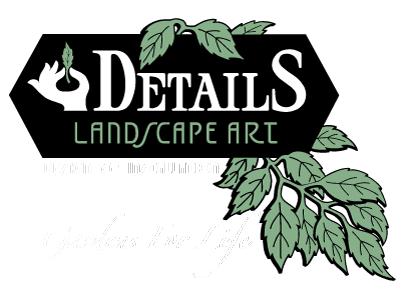Acid loving plants are an important part of the garden. Details Landscape Art is a Petaluma landscape contractor with projects throughout Sonoma County. We are a design-build firm, specializing in the installation of drop dead gorgeous residential gardens.
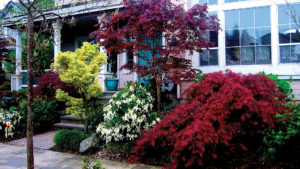
The first step in planning a garden, and specifically the type of medium available, is to test the soil pH. Acid loving plants prefer a soil of about 5.5 pH. A neutral soil can be amended, as we will discuss below.
The list of acid loving plants is long. Following is a list, by category, of plant material that is popular and usually available in our area. We will discuss in detail the shrub category, since almost every garden can use these shade-loving acid loving plants.
Fruits and Vegetables:
Radishes, sweet potatoes, parsley, peppers, potatoes, rhubarb, blueberries, cranberries, currants, elderberries, gooseberries, beans, broccoli, cabbage, carrots, cucumbers, onions, squash, sweet corn, tomatoes, turnips, grapes, raspberries, and strawberries all are acid loving.
Trees:
- Dogwood – this smallish, shade loving tree is a perfect companion to the shade loving, acid loving shrubs.
- Apples – many varieties.
- Magnolia
- Beech
Flowers:
Marigolds, Iris, Caladium, nasturtium, daffodils, begonias
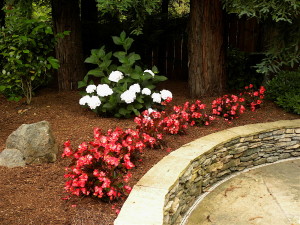
Shrubs:
The following group of shrubs are not only acid loving, but also shade loving. They do well as understory plants, especially under conifers like redwoods, cedars and fir. These are trees that PRODUCE acid (as well as shade), and the needle droppings are a great supplemental source of acid for these plants. It also follows naturally, that acid loving plants that are not planted under these types of trees, can benefit from being planted directly in the bark of these trees outside of their canopy. So, for example, in the afternoon shade of a structure or home, these plants will thrive when planted in fir bark, and supplemented with acid in ensuing years with addition fresh bark.
- Azaleas – there are many varieties, too numerous to list here. Most are full shade. The ‘Southern Indica’ family of azaleas can be grown in full sun. Azaleas are not deer resistant.
- Rhododendrons – part of the azalea family, rhodys produce larger flowers and generally larger leaves than azaleas. They are deer resistant.
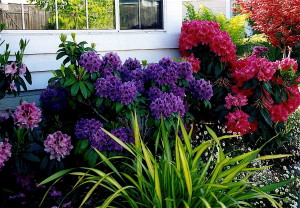
- Camellias – soooo many varieties available. They can be classified into two main groups: camellia ‘sasanqua’, which grow more horizontally and spread quickly are generally winter to early spring bloomers. Camellia japonica is a more upright group of camellias that bloom anywhere from early spring to as late as May.
- Pieris japonica – this is one of our favorite plants in the garden. There are many types, varying greatly as to height and width, flower color, and leaf color. We LOVE Pieris ‘Temple Bells’ which grows to about five feet tall, and produces a profusion of weeping pure whiten flowers in spring. One of its special characteristics is the new leaf growth in spring, which appear a brilliant orange-red color before fading to green.
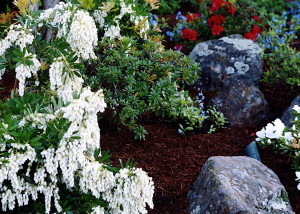 The four plants listed above (azaleas, rhododendrons, camellias and pieris) are all spring bloomers. Planting shade gardens with grouping of these plants and moss covered boulders and perhaps a dogwood or two yields a spectacular spring garden.
The four plants listed above (azaleas, rhododendrons, camellias and pieris) are all spring bloomers. Planting shade gardens with grouping of these plants and moss covered boulders and perhaps a dogwood or two yields a spectacular spring garden.
- Hydrangeas –
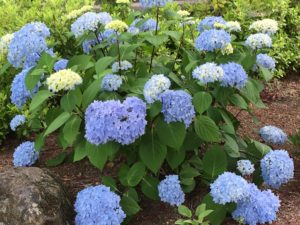
When the above spring blooming garden’s flowers fade, enter the hydrangeas. When planted among the spring flowering acid loving plants, the hydrangeas will provide summer color in spades. They are available in pink, white and blue flowered mopheads, as well as several lace leaf types.
- Mondo grass – this is a low clumping, spreading groundcover that fills in between the above plantings.
